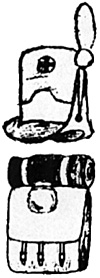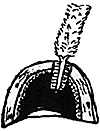Minifigs
1/5 Graham Road, Southampton. SO2 0AX
Tel: 0703 220855. Price 95p per pack. Catalogue available.
MINIFIGS have just released 20 new packs in a range entitled the Swedish Napoleonic Army 1807. These figures are of extremely high quality, cleanly cast and showing great detail. When I stood them next to MINIFIGS Russian and French infantrymen they appeared slightly taller and not quite as chunky.
A new innovation for MINIFIGS was to cast the horse with shabraque but without valise or pistol holsters. The pistol holsters were cast onto the rider while the valises were supplied separately.
Infantry
 Infantryman Advancing (4ND), March Attack (5ND), Standing Firing (6ND) and Kneeling Firing (7ND).
Infantryman Advancing (4ND), March Attack (5ND), Standing Firing (6ND) and Kneeling Firing (7ND).
These figures represent the Provincial (Indelta) Infantry regiments. The upturned brim on the left side of the hat is too wide, looking like the Austrian model and not the Swedish [see sketch]. This uniform was worn from 1807 until the end of the Napoleonic wars although the jacket changed from having one row of buttons to two, this cannot be seen in 15mm. The large backpack worn by these figures was not adopted by the Swedish army until just prior to the 1813 campaign. Before this the infantry had a smaller knapsack which was worn on the left hip, and which was left at the rear with the baggage when the regiment went into action. Perhaps they should have been supplied loose like the cavalry valises, then the wargamer would have the option of making the figure for 1807 or 1813. The canteen is of "English" model, not that used by the Swedes, and should have been carried in the middle of the backpack, and not on the left hip [see sketch].
Grenadier/Life Guard Advancing (1ND), March Attack (2ND) and Standing Firing (3ND)
These figures represent the Life Guard (Lifgardet) and not as MINIFIGS claim the grenadier regiments. This uniform was worn from 1807 to the end of the Napoleonic wars, although like the Provincial infantry, the backpack dates them to 1813.
If it is desired to convert them into grenadiers, this can be accomplished without too much work. Firstly the grenadiers had a single breasted jacket and not a double breasted coat, a thick covering of blue paint can easily rectify this. Secondly the crest should be removed and a new one added with milliput - the Life Grenadier Regiment wore the crest from side to side while the Life Regiment's Grenadier Corps wore it fore and aft. Finally the epaulets should be removed for the Life Grenadier Regiment.
Command (8ND)
 This packet contains one mounted officer and five foot figures. Three of these represent the Provincial Infantry Command, an Officer, a Standard Bearer and a Drummer. Only two figures are used for the Life Guard/Grenadier Command, an Officer and a Drummer.
This packet contains one mounted officer and five foot figures. Three of these represent the Provincial Infantry Command, an Officer, a Standard Bearer and a Drummer. Only two figures are used for the Life Guard/Grenadier Command, an Officer and a Drummer.
The Life Guard/Grenadier officer wears a hat with oblique crest. For Grenadier officers this should be replaced by the same crest as the rank and file, while the Life Guard officers should wear a bicorn [see sketch]. I wonder why it was not though necessary to include a standard bearer for the Life Guards/Grenadiers.
The idea of having only one command pack does not appeal to me. I have considerably more line units than elite in my armies, and a system which makes me purchase an equal number of elite and line drummers is to be scorned. Wargames armies should be historically composed, and armies with 50% elite infantry should not be encouraged by the manufacturers.
Artillery
Artillerymen (21ND)
This pack includes six figures all in different poses wearing the 1807 artillery uniform. Horse artillery wore the same uniform with the addition of a gold aiguillette hanging from the right shoulder.
This is one of the best sets of artillery figures I have ever seen, with all of the figures in interesting poses.
MINIFIGS did not release any artillery equipment for these figures. Swedish cannon had frame trails so maybe Prussian or Russian pieces can be used. The limbers were not unlike those used by the British artillery. The draft horses had a shabraque like that used by the hussars, and all had riders (unlike most other nations who only mounted the left side).
Cavalry
As normal, the cavalry packs contain either four identical troopers or an officer, a standard bearer and a trumpeter.
These figures are all well detailed and in a variety of different poses, I specifically liked the fact that the cavalry are not resting their sabres on their shoulders (which was almost a trademark of MINIFIGS cavalry troopers).
By 1807 the Swedish cavalry carried neither carbines nor dragoon muskets, so these should be removed from the MINIFIGS troopers.
Life Regiment's Cuirassier Corps Trooper (1NDC) and Command (10NDC).
These figures are wearing the full dress uniform of the Life Regiment's Cuirassier Corps (Lifregementets kuirassierkar). In the field they wore the same uniform as the Skanska Carabiniers (bicorne and no cuirass), a uniform not unlike that worn by the early British heavy cavalry.
Vastgota Dragoon Trooper (2NDC) and Command (11NDC).
These figures wear the 1807 uniform of the Vastgota Dragoon Regiment, which was worn until 1811 when the regiment was converted into infantry.
Light Dragoon Trooper (3NDC), Trooper with carbine (5NDC) and Command (12NDC).
These figures represent the Smalands Light Dragoons (1806-1810) or the Nylands (Finnish) Dragoons (1806-1809).
Hussar Trooper (4NDC) and Command (13NDC).
These hussars wear the "standard" hussar uniform of dolman and pelisse. The figures wear a shako which is not the normally depicted headdress for Swedish hussars. These regiments (the Skanska and Mornerska Hussars and the Life Regiment's Hussar Corps) are usually shown wearing the mirliton, even after it had gone out of fashion in the other Napoleonic armies. A hussar uniform from this period, with mirliton, is preserved in the Swedish Army Museum.
Mounted Life Guard Trooper (6NDC) and Command (14NDC).
These figures wear the 1807-1810 uniform of the Mounted Life Guard (Lifgardet till Hast), not that of a dragoon regiment as suggested by MINIFIGS. They are wrongly wearing epaulets. After 1810 they wore the same uniform, but the hat was replaced by a shako.
If this review sounds negative, it was not meant to be so. I liked these figures and think MINIFIGS did an outstanding job considering the lack of information in English on these regiments. Although I have stressed a number of minor errors, I hope that I have also provided the wargamer with enough information to easily rectify them.
More Reviews
-
Falcon Figures 15mm Spanish 1806-1812
Minifigs 15mm Swedish Napoleonic Range
Bicorne Miniatures 25mm Napoleonic
Napoleonic Scenarios (Book)
Hougoumont [Command Magazine] (board wargame)
Empires in Arms (board wargame)
Back to Table of Contents -- First Empire #5
Back to First Empire List of Issues
Back to MagWeb Master Magazine List
© Copyright 1992 by First Empire.
This article appears in MagWeb (Magazine Web) on the Internet World Wide Web. Other military history articles and gaming articles are available at http://www.magweb.com